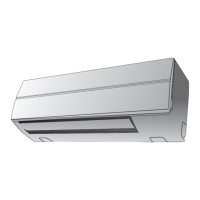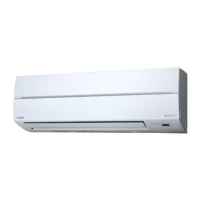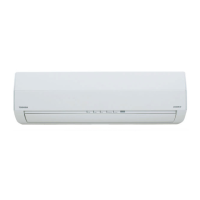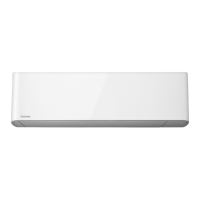Do you have a question about the Toshiba RAS-16SKV-E and is the answer not in the manual?
Detailed technical specifications for indoor and outdoor units, including capacities and dimensions.
Safety precautions for handling R410A refrigerant during installation and servicing.
Guidelines and materials for installing refrigerant piping, including pipe types and joints.
Exploded view and dimensions of the indoor unit, showing key components and mounting details.
Exploded view and dimensions specific to certain indoor unit models, detailing parts and assembly.
Exploded view and dimensions of the outdoor unit, illustrating external features and installation aspects.
Wiring diagram for specific indoor and outdoor unit model combinations, detailing electrical connections.
Wiring diagram for different indoor and outdoor unit model combinations, illustrating electrical connections.
List of electrical components used in the indoor unit, with their model names and specifications.
List of electrical components used in the outdoor unit, including their model names and ratings.
Schematic diagram illustrating the refrigerant flow and key components within the air conditioning system.
Block diagram showing the control logic and communication flow for the indoor unit and remote controller.
Block diagram detailing the control functions and components of the outdoor unit's microcomputer and inverter assembly.
Overview of the air conditioner's control system, roles of indoor and outdoor controllers, and signal communication.
Detailed explanation of various operation modes and functions, including fan control and capacity adjustment.
Description and procedure for setting up the auto restart function after power failure.
Identification of remote control buttons and operation procedures for various functions and modes.
Essential safety precautions to be followed before and during the installation process.
List of optional parts, accessories, and tools required for installation, with part codes and quantities.
Details on tools required for R410A installation and servicing, highlighting differences from R22 tools.
Procedures for installing the indoor unit, including placement, drilling, and mounting the installation plate.
Guidelines for selecting the installation place for the outdoor unit, considering noise, wind, and gas.
Procedure for evacuating air from the refrigerant pipes using a vacuum pump, including important precautions.
Steps for connecting the electrical wiring between the indoor and outdoor units, including cable types and connection methods.
Initial checks for power supply and voltage, and identifying normal operation behaviors.
Methods for diagnosing troubles, starting with flashing LED indicators on the indoor unit.
Interpretation of indoor unit LED flashing patterns for self-diagnosis and error identification.
Using the remote controller in service mode to retrieve specific check codes for detailed self-diagnosis.
Troubleshooting based on observed symptoms, focusing on power issues and indoor unit behavior.
Diagnosing issues related to wiring failures in interconnecting and serial signal wires.
Troubleshooting specific error codes 1C and 1E related to miswiring or sensor issues.
Step-by-step troubleshooting guides for air purifier and ion generator functions.
Diagnostic procedures for troubleshooting issues within the outdoor unit's inverter assembly.
Procedures for checking the main components, including indoor unit PC boards and sensors.
Procedures for disassembling and replacing main parts of the indoor unit, starting with the front panel.
Procedures for replacing the microcomputer and related PC board components.
Procedures for disassembling and replacing main parts of the outdoor unit, including cabinets and covers.
Exploded view and parts list for the indoor unit, itemizing components with their part numbers.
Continuation of the indoor unit's exploded view and parts list, detailing PCBs and sensors.
Exploded view and parts list for the outdoor unit, showing components and their part numbers.
Diagram illustrating the layout of components on the PC boards for both indoor and outdoor units.
Detailed technical specifications for indoor and outdoor units, including capacities and dimensions.
Safety precautions for handling R410A refrigerant during installation and servicing.
Guidelines and materials for installing refrigerant piping, including pipe types and joints.
Exploded view and dimensions of the indoor unit, showing key components and mounting details.
Exploded view and dimensions specific to certain indoor unit models, detailing parts and assembly.
Exploded view and dimensions of the outdoor unit, illustrating external features and installation aspects.
Wiring diagram for specific indoor and outdoor unit model combinations, detailing electrical connections.
Wiring diagram for different indoor and outdoor unit model combinations, illustrating electrical connections.
List of electrical components used in the indoor unit, with their model names and specifications.
List of electrical components used in the outdoor unit, including their model names and ratings.
Schematic diagram illustrating the refrigerant flow and key components within the air conditioning system.
Block diagram showing the control logic and communication flow for the indoor unit and remote controller.
Block diagram detailing the control functions and components of the outdoor unit's microcomputer and inverter assembly.
Overview of the air conditioner's control system, roles of indoor and outdoor controllers, and signal communication.
Detailed explanation of various operation modes and functions, including fan control and capacity adjustment.
Description and procedure for setting up the auto restart function after power failure.
Identification of remote control buttons and operation procedures for various functions and modes.
Essential safety precautions to be followed before and during the installation process.
List of optional parts, accessories, and tools required for installation, with part codes and quantities.
Details on tools required for R410A installation and servicing, highlighting differences from R22 tools.
Procedures for installing the indoor unit, including placement, drilling, and mounting the installation plate.
Guidelines for selecting the installation place for the outdoor unit, considering noise, wind, and gas.
Procedure for evacuating air from the refrigerant pipes using a vacuum pump, including important precautions.
Steps for connecting the electrical wiring between the indoor and outdoor units, including cable types and connection methods.
Initial checks for power supply and voltage, and identifying normal operation behaviors.
Methods for diagnosing troubles, starting with flashing LED indicators on the indoor unit.
Interpretation of indoor unit LED flashing patterns for self-diagnosis and error identification.
Using the remote controller in service mode to retrieve specific check codes for detailed self-diagnosis.
Troubleshooting based on observed symptoms, focusing on power issues and indoor unit behavior.
Diagnosing issues related to wiring failures in interconnecting and serial signal wires.
Troubleshooting specific error codes 1C and 1E related to miswiring or sensor issues.
Step-by-step troubleshooting guides for air purifier and ion generator functions.
Diagnostic procedures for troubleshooting issues within the outdoor unit's inverter assembly.
Procedures for checking the main components, including indoor unit PC boards and sensors.
Procedures for disassembling and replacing main parts of the indoor unit, starting with the front panel.
Procedures for replacing the microcomputer and related PC board components.
Procedures for disassembling and replacing main parts of the outdoor unit, including cabinets and covers.
Exploded view and parts list for the indoor unit, itemizing components with their part numbers.
Continuation of the indoor unit's exploded view and parts list, detailing PCBs and sensors.
Exploded view and parts list for the outdoor unit, showing components and their part numbers.
Diagram illustrating the layout of components on the PC boards for both indoor and outdoor units.
| Brand | Toshiba |
|---|---|
| Model | RAS-16SKV-E |
| Category | Air Conditioner |
| Language | English |











